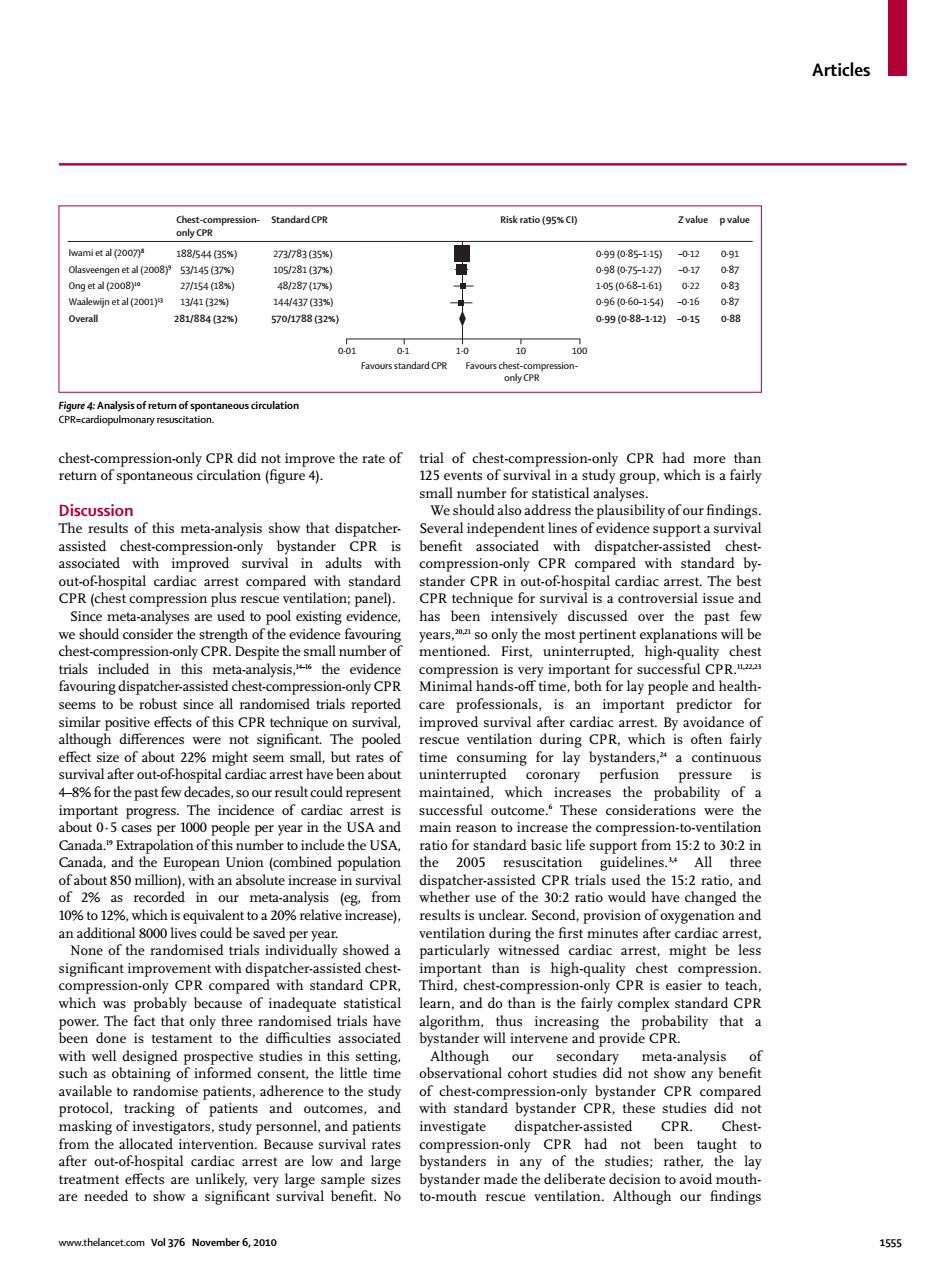正在加载图片...

Articles h5 net al (2001 13/4162 96060-15 0 TrAnassofre hest- sion-only CPR did no e the rate of trial of chest-co only CPR had tha retur of spontaneous circulation (figure4). 125 events of survi in a study group. Discussion of this met show that Several independent lin compression-only CPR compa red with standard by are use d topool existing evidence has been intensively discussed over the past fev sion-only CPR De e the small number of ualit the evic succe is an important predictor for but rates of time consuming for lay bystanders,a 4-8%6 for the past few d maintained.which inc ases the probability of a nce of USA and successful These considerations were the es pe from 15:2 030:2i1 of the would have changed th rdiac ar arly st,might be t-compression ct that ony thre the don testament to the pobablydaC nde P such obse any benefit va nstirgofnesigatorsshdpesoneLandptent investigate ner-assisted CPR. after out ofhospital cardiac arrest are low and larg bystanders in any bystande rmade the de 2010 15Articles www.thelancet.com Vol 376 November 6, 2010 1555 chest-compression-only CPR did not improve the rate of return of spontaneous circulation (fi gure 4). Discussion The results of this meta-analysis show that dispatcherassisted chest-compression-only bystander CPR is associated with improved survival in adults with out-of-hospital cardiac arrest compared with standard CPR (chest compression plus rescue ventilation; panel). Since meta-analyses are used to pool existing evidence, we should consider the strength of the evidence favouring chest-compression-only CPR. Despite the small number of trials included in this meta-analysis,14–16 the evidence favouring dispatcher-assisted chest-compression-only CPR seems to be robust since all randomised trials reported similar positive eff ects of this CPR technique on survival, although diff erences were not signifi cant. The pooled eff ect size of about 22% might seem small, but rates of survival after out-of-hospital cardiac arrest have been about 4–8% for the past few decades, so our result could represent important progress. The incidence of cardiac arrest is about 0·5 cases per 1000 people per year in the USA and Canada.19 Extrapolation of this number to include the USA, Canada, and the European Union (combined population of about 850 million), with an absolute increase in survival of 2% as recorded in our meta-analysis (eg, from 10% to 12%, which is equivalent to a 20% relative increase), an additional 8000 lives could be saved per year. None of the randomised trials individually showed a signifi cant improvement with dispatcher-assisted chestcompression-only CPR compared with standard CPR, which was probably because of inadequate statistical power. The fact that only three randomised trials have been done is testament to the diffi culties associated with well designed prospective studies in this setting, such as obtaining of informed consent, the little time available to randomise patients, adherence to the study protocol, tracking of patients and outcomes, and masking of investigators, study personnel, and patients from the allocated intervention. Because survival rates after out-of-hospital cardiac arrest are low and large treatment eff ects are unlikely, very large sample sizes are needed to show a signifi cant survival benefi t. No trial of chest-compression-only CPR had more than 125 events of survival in a study group, which is a fairly small number for statistical analyses. We should also address the plausibility of our fi ndings. Several independent lines of evidence support a survival benefi t associated with dispatcher-assisted chestcompression-only CPR compared with standard bystander CPR in out-of-hospital cardiac arrest. The best CPR technique for survival is a controversial issue and has been intensively discussed over the past few years,20,21 so only the most pertinent explanations will be mentioned. First, uninterrupted, high-quality chest compression is very important for successful CPR.11,22,23 Minimal hands-off time, both for lay people and healthcare professionals, is an important predictor for improved survival after cardiac arrest. By avoidance of rescue ventilation during CPR, which is often fairly time consuming for lay bystanders,24 a continuous uninterrupted coronary perfusion pressure is maintained, which increases the probability of a successful outcome.6 These considerations were the main reason to increase the compression-to-ventilation ratio for standard basic life support from 15:2 to 30:2 in the 2005 resuscitation guidelines.3,4 All three dispatcher-assisted CPR trials used the 15:2 ratio, and whether use of the 30:2 ratio would have changed the results is unclear. Second, provision of oxygenation and ventilation during the fi rst minutes after cardiac arrest, particularly witnessed cardiac arrest, might be less important than is high-quality chest compression. Third, chest-compression-only CPR is easier to teach, learn, and do than is the fairly complex standard CPR algorithm, thus increasing the probability that a bystander will intervene and provide CPR. Although our secondary meta-analysis of observational cohort studies did not show any benefi t of chest-compression-only bystander CPR compared with standard bystander CPR, these studies did not investigate dispatcher-assisted CPR. Chestcompression-only CPR had not been taught to bystanders in any of the studies; rather, the lay bystander made the deliberate decision to avoid mouthto-mouth rescue ventilation. Although our fi ndings Figure 4: Analysis of return of spontaneous circulation CPR=cardiopulmonary resuscitation. 0·99 (0·85–1·15) 0·98 (0·75–1·27) 1·05 (0·68–1·61) 0·96 (0·60–1·54) 0·99 (0·88–1·12) –0·12 –0·17 0·22 –0·16 –0·15 0·91 0·87 0·83 0·87 0·88 188/544 (35%) 53/145 (37%) 27/154 (18%) 13/41 (32%) 281/884 (32%) 273/783 (35%) 105/281 (37%) 48/287 (17%) 144/437 (33%) 570/1788 (32%) Chest-compressiononly CPR Standard CPR Iwami et al (2007)8 Olasveengen et al (2008)9 Ong et al (2008)10 Waalewijn et al (2001)13 Overall Risk ratio (95% CI) Z value p value Favours standard CPR Favours chest-compressiononly CPR 0·01 0·1 1·0 10 100